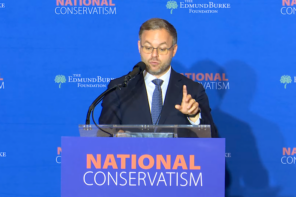For all his talk of protecting religious freedom, one of the First Amendment’s five sacred rights, it’s taken President Donald Trump less than one week to start kicking the legs out from under each of the others.
The new administration has launched aggressive attacks on a free and fair press, freedom of speech, and the right of the citizenry to peaceably assemble and petition the government for a redress of grievances. One could even argue that he’s weakened the free expression of religion (or lack thereof), particularly as it refers to contraception, LGBT rights, and any non-Christian faith practices.
Take the freedom of the press and the right to assembly. At least six journalists are being charged with felony rioting for covering Inauguration Day protests that turned violent, according to The New York Times. Such severe charges against journalists who were, by all accounts, reporting on a newsworthy public event, are highly unusual in modern American history. The formal charges against the journalists allege that demonstrators were carrying what the Times calls “anarchist flags,” but nowhere does the document “accuse any individual journalist of criminal activity.”
Couple this with Press Secretary Sean Spicer’s hostile introduction to the White House Press Corps, which itself suggests the incoming administration will have a “chilling” effect on the press, and it begins to feel like we’re just seeing the tip of the iceberg. As Mashable notes, the new administration’s relationship with the press is already resembling that of Richard Nixon or, more ominously, Russian President Vladimir Putin’s systematic dismantling of the independent press. In fact, top White House adviser Steve Bannon last night told the Times that he views American news media as the “opposition party,” which should, in his words, “keep its mouth shut.”
Of course, Trump’s gag order extends well beyond the White House Press Corps. Among a cascade of executive actions authored in his first few days, the new president ordered federal agencies to stop communicating with the press, freeze all current reports and studies, and, tellingly, tried to discourage them from using Twitter.
No one in the administration has directly commented on the irony that the chief executive, who prefers to issue his fiats in 140-character outbursts, feels it necessary to censor government agencies that dare to tweet facts about the resources they protect. Regardless, this kind of content-specific censure goes against longstanding American standards that (at least in theory) champion a vibrant and open socio-political national conversation.
Finally, draft versions of the president’s proposed immigration restriction suggest that all the nations involved will be Muslim-majority nations, which makes is difficult to square with the principle of religious freedom. As The Atlantic explained:
“If implemented, the Trump administration’s order would suspend the entire U.S. Refugee Admissions Program for 120 days while security measures are reviewed and ban Syrian refugees from U.S. entry indefinitely. It would also temporarily block entry visas from seven countries—Iraq, Syria, Iran, Sudan, Somalia, Yemen, and Libya—for 30 days as part of a broader security review of visa-admission programs, after which permanent visa bans could be enacted for those countries and others.”
Take this transparent attempt to privilege Judeo-Christian faith traditions in immigration policy and combine it with the so-called First Amendment Defense Act, which Trump has promised to sign, and VP Mike Pence’s long history of deploying “religious freedom” as a weapon to restrict LGBT and reproductive rights, and the administration is, at best, boldly picking favorites when it comes to faith-informed morality. There’s no reason to suggest this early trend will reverse itself, and if one of Trump’s preferred Supreme Court nominees is confirmed, the nation may be in for a religious reckoning, where not burdening “sincerely held beliefs” categorically outweighs protecting civil and human rights.





